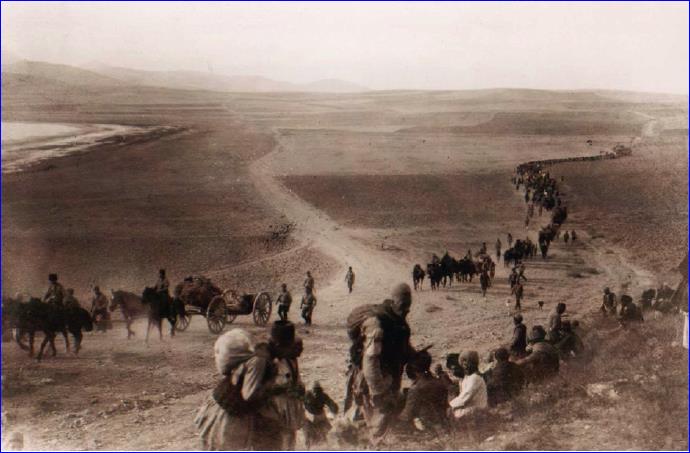


 Basile Nikitine, handed over to Dominican missionaries, Paris)
Basile Nikitine, handed over to Dominican missionaries, Paris)
Prof. Yacoub is an Assyrian (also known as Chaldean and Syriac). He was the first chairholder of UNESCO's 'Memory, cultures and interculturality', expert on minorities, human rights and Eastern Christians. His parents, originally from Iranian Azerbaijan (Salamas district), suffered during the Turkish genocide of Assyrians during World War I, taking refuge in the Caucasus (Georgia) before settling in Syria in 1921. Prof. Yacoub is author of several books, among them an English book titled Year of the Sword - The Assyrian Genocide, A History (AINA 2016-11-27).
In his article Prof. Yacoub starts by reminding readers that in 1915 hundreds of thousands of Assyrians suffered in the Armenian, Assyrian and Greek genocide committed by Ottoman Turks during World War I, a genocide that met all the criteria of the UN Genocide Convention of 1948 (AINA 2012-03-91, 2007-01-15). A century later, the international community witnessed another genocide of Assyrians in Iraq and Syria committed by the Islamic State of Iraq and Syria (ISIS).
Prof. Yacoub highlights numerous acts and scenes of horror that mark the history of the Assyrians, who became victims of pan-Turkism and pan-Islamism in eastern Turkey and northern Iran between 1915-1918. They lost 75% of their population (750,000) to massacre, death marches, hunger and starvation. The aim of the Ottoman government was to eliminate them under the pretext of evacuation from the geographical areas deemed sensitive from a Turkish nationalism point view. Kurdish irregulars were mainly used to eradicate the Christian population. This genocide, recognized by international genocide scholars (AINA 2007-12-15) and many parliaments of many countries is in accordance with the definition of the term given by the UN Convention of December 9, 1948.
Related: The Assyrian Genocide
The tragedy suffered by the Assyrians under the Ottoman Empire "continues now under other skies," writes Prof. Yacoub. For Assyrians, the 21st century started with persecution in Iraq (since 2004) and Syria (since 2011). Ironically, the 2015 Assyrian victims of ISIS in Khabour, northeast Syria, were descendants of refugees from Iraq who settled there in 1933, whose parents were themselves survivors of the 1915 genocide. Once again, they were driven out by Muslims, like their brothers in Mosul and from the Nineveh region.
Related: Timeline of ISIS in Iraq
Related: Attacks on Assyrians in Syria By ISIS and Other Muslim Groups
Far from being resettled in Iraq after the defeat of ISIS, their drama continues in northeast Syria, because they have been living in uncertainty since the proclamation of the Kurdish rule in 2012 and also by the Turkish military offensive since October, 2019. Weakened and existentially threatened, more than half of the Christian population in Syria took the path of exile, says Prof. Yacoub.
Commenting on the events that lead to the 1915 genocide, Prof. Yacoub says,
To understand 1915-1918, it is necessary go back to 1907, looking at the evolution of the Ottoman Empire and its decline process. From that year on, the Turks began to mingle with Iranian politics, with ambitions declared on the region of Azerbaijan, supported by the Kurds who acted like their agents and charged with plundering villages...Turkish-Kurdish invasions thus devastated in 1907-1908 of the Christian villages of the mountains of Iran as Mavana, inhabited by more than 1,000 Assyrians, which caused an exodus to the town of Urmia. William A. Shedd, American Presbyterian missionary in Ourmia, wrote in 1916: "The Turks occupied in 1906 a strip of territory along the Persian border stretching from Soujboulak to southwest to Khoi to the west.
The Young Turks Revolution (1908-1909), which ended the despotic reign of Sultan Abdel-Hamid, was initially welcomed by the Christian communities. However, it quickly gave way to oppressive and genocidal nationalism.
Prof. Yacoub points to an interesting fact, that prior to the entry into World War I, and on September 9, 1914, the Turkish government unilaterally abolished the so-called capitulary system, which were agreements granting European powers a set of favorable and exclusive rights in the Ottoman Empire while recognizing them as the protective powers of the Christian minorities. In the pre-war political atmosphere of islamization, this seemed like opening the way for non-Muslim communities. Before the war was officially declared, massacres took place in Bachkalé (kaza of Albaq) in the districts of Gavar and Shemsdinan, located northwest of the Hakkari Mountains, towards the Turkish-Persian border, and other areas.
Related: Genocides Against the Assyrian Nation
As the war began, the Assyrians were extremely shocked to see Germany supporting Turkey and its call for jihad, while German missionaries were managing some schools and orphanages in the region for them. Prof. Yacoub continues with details related to the process of genocide with references to eyewitnesses, particularly missionaries, and documents. He elaborates on the impact of the Bolshevik Revolution 1917 on the events related to the Assyrians in the Caucasus and Urmia.
Prof. Yacoub also discusses the ethnocide aspect in context of the genocide, which, through its dismal policy, sought to destroy the cultural heritage of a people:
This physical genocide and this spoliation of lands and property was accompanied by serious damage to the cultural inheritance cultural. Historical monuments were destroyed while churches were desecrated churches and schools demolished. Libraries containing rare books and rich manuscripts have been squandered, like those of the Chaldean diocese of Séert... The Hakkari region counted over 200 churches, the oldest of which date back to 4th century. The Assyrians were thus dispossessed of a large part of their places of memory and their culture. In all, more than 400 churches and convents were ruined, including 156 Syriac Orthodox.
Prof. Yacoub concludes with the recognition initiatives by Western parliaments while presenting a list of source documents related to the genocide of the Assyrians.

or register to post a comment.